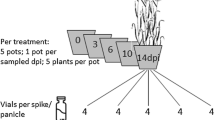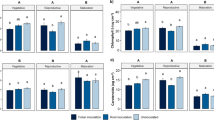Summary
Conidia ofFusarium oxysporum f. sp.vasinfectum started to germinate on the roots of cotton (Gossypium barbadense L.) 6 h after inoculation and formed a compact mycelium covering the root surface. 18 h later, penetration hyphae branched off and infected the root. The number of penetration hyphae increased with the number of conidia used for inoculation. The optimal temperature for penetration was between 28 and 30 °C. The highest numbers of penetration hyphae were found in the meristematic zone, 40 percent less in the elongation and root hair zones, and none in the lateral root zone. The fine structure of the infection process was studied in protodermal cells of the meristematic zone and in rhizodermal cells of the elongation zone. The penetration hyphae were well preserved after freeze substitution and showed a Golgi equivalent consisting of three populations of smooth cisternae. Plant reactions were found already during fungal growth on the root surface. In the meristematic zone, a thickening of the plant cell wall due to an apposition of dark and lightly staining material below the hyphae occurred. This wall apposition increased in size around the hypha invading the plant cell and led to the formation of a prominent wall apposition with finger-like projections into the host cytoplasm. In the elongation zone, the deposits around the penetration hypha appeared less thick and the dark inclusions were less pronounced. High pressure freezing of infected cells revealed, thatF. oxysporum penetrates and grows within the host cells without inducing damages such as plasmolysis, cell degeneration or even host necrosis. We suggest thatF. oxysporum has an endophytic or biotrophic phase during colonization of the root tips.
Similar content being viewed by others
Abbreviations
- Ph:
-
penetration hyphae
References
Alconero R (1968) Infection and development ofFusarium oxysporum f. sp.vanillae in vanilla roots. Phytopathology 58: 1281–1283
Armstrong GM, Armstrong JK (1981) Formae specialis and races ofFusarium oxysporum causing wilt diseases. In: Nelson PE, Tousson TA, Cook RJ (eds) Fusarium: diseases, biology, and taxonomy. The Pennsylvania State University Press, University Park, PA, pp 391–399
Beckman CH (1987) The nature of wilt diseases of plants. American Phytopathological Society, St Paul, MN
Beswetherick JT, Bishop CD (1993) An ultrastructural study of tomato roots inoculated with pathogenic and non-pathogenic necrotrophic fungi and a saprophytic fungus. Plant Pathol 42: 577–588
Bhalla MK, Nozzolillo C, Schneider E (1992) Observations on the responses of lentil root cells to hyphae ofFusarium oxysporum. J Phytopathol 135: 335–342
Bhatti MA, Kraft JM (1992) Effects of inoculum density and temperature on root rot and wilt of chickpea. Plant Dis 76: 50–54
Bishop CD, Cooper RM (1983) An ultrastructural study of vascular colonization in three vascular wilt diseases. I. Colonization of susceptible cultivars. Physiol Mol Plant Pathol 23: 323–343
Brammall RA, Higgins VJ (1988) A histological comparison of fungal colonization in tomato seedlings susceptible and resistant toFusarium crown root rot disease. Can J Plant Pathol 66: 915–925
Bonfante-Fasolo P, Peretto R, Perotto S (1992) Cell surface interactions in endomycorrhizal symbiosis. In: Callow JA, Green JA (eds) Perspectives in plant cell recognition. Cambridge University Press, Cambridge, pp 239–255
Curl EA, Truelove B (1986) The rhizosphere. Springer, Berlin Heidelberg New York Tokyo
Deacon JW, Donaldson SP (1993) Molecular recognition in the homing responses of zoosporic fungi, with special reference toPhytium andPhytophthora. Mycol Res 97: 1153–1171
Elmer WH, Lacy ML (1987) Effects of inoculum densities ofFusarium oxysporum f. sp.apii in organic soil on disease expression in celery. Plant Dis 71: 1086–1089
Fahn A (1982) Plant anatomy. Pergamon, Oxford
Farquhar ML, Peterson L (1989) Pathogenesis inFusarium root rot of primary roots ofPinus resinosa grown in test tubes. Can J Plant Pathol 11: 221–228
Fisher PJ, Petrini O (1992) Fungal saprobes and pathogens as endophytes of rice (Oryzasativa). New Phytol 120: 137–143
Gardiner DC, Horst RK, Nelson PE (1989) Influence of night temperature on disease development inFusarium wilt of chrysanthemum. Plant Dis 73: 34–37
Gerick JS, Huisman OC (1985) Mode of colonization of roots byVerticillium andFusarium. In: Parker CA, Rovira AD, Moore JK, Wong TW, Kollmorgen JS (eds) Ecology and management of soilborne plant pathogens. American Phytopathological Society, St Paul, MN, pp 80–83
Hallman J, Sikora RA (1994) Influence ofFusarium oxysporum, a mutualistic fungal endophyte, onMeloidogyne incognita. J Plant Dis Protec 101: 475–481
Harder DE, Chong J (1990) Rust haustoria. In: Mendgen K, Leseman DE (eds) Electron microscopy of plant pathogens. Springer, Berlin Heidelberg New York Tokyo, pp 235–250
Hardham AR (1992) Cell biology of pathogenesis. Annu Rev Plant Physiol Plant Mol Biol 43: 491–526
Hayat MA (1975) Positive staining for electron microscopy. Van Nostrand Rheinhold, New York
Hornby D (1990) Root diseases. In: Lynch JM (eds) The rhizosphere. Wiley, Chichester, pp 233–258
Howard RJ (1981) Ultrastructural analysis of hyphal tip cell growth in fungi: Spitzenkörper, cytoskeleton and endomembranes after freeze substitution. J Cell Sci 48: 89–103
Huisman OC, Gerick JS (1989) Dynamics of colonization of plant roots byVerticillium dahliae and other fungi. In: Tjamos EC, Beckman CH (eds) Vascular wilt disease of plants. Springer, Berlin Heidelberg New York Tokyo, pp 1–17
Jordan CM, Endo RM, Jordan LS (1987) Penetration and colonization of resistant and susceptibleApium graveolens byFusarium oxysporum f. sp.apii race 2: callose as a structural response. Can J Bot 66: 2385–2391
Kiss JK, Giddings TH Jr, Staehelin LA, Sack FD (1990) Comparison of the ultrastructure of conventionally fixed and high pressure frozen/freeze substituted root tips ofNicotiana andArabidopsis. Protoplasma 157: 64–74
Knauf GM, Welter K, Müller M, Mendgen K (1989) The haustorial host-parasite interface in rust-infected bean leaves after highpressure freezing. Physiol Mol Plant Pathol 34: 519–530
Mace ME, Bell AA, Stipanovic RD (1974) Histochemistry and isolation of gossypol and related terpenoids in roots of cotton seedlings. Phytopathology 64: 1297–1302
Marschner H (1992) Nutrient dynamics at the soil-root interface (rhizosphere). In: Read DJ, Lewis DH, Fitter AH, Alexander IJ (eds) Mycorrhizas in ecosystems. CAB International, Wallingford, pp 3–12
Mendger K, Bachem U, Stark-Urnau M, Xu H (1995) Secretion and endocytosis at the interface of plants and fungi. Can J Bot (in press)
—, Welter K, Scheffold F, Knauf-Beiter G (1990) High pressure freezing of rust infected plant leaves. In: Mendgen K, Leseman DE (eds) Electron microscopy of plant pathogens. Springer, Berlin Heidelberg New York Tokyo, pp 31–41
O'Connell RJ (1987) Absence of a specialized interface between intracellular hyphae ofColletotrichum lindemunthianum and cells ofPhaseolus vulgaris. New Phytol 107: 725–734
Parry DW, Pegg CF (1985) Surface colonization, penetration and growth of threeFusarium species in lucerneMedicago sativa. Trans Br Mycol Soc 85: 495–500
Postma J, Rattink H (1991) Biological control of Fusarium wilt of carnation with a nonpathogenic isolate ofFusarium oxysporum. Can J Bot 70: 1199–1205
Rodríguez-Gálvez E, Menden K (1995) Cell wall synthesis in cotton roots after infection withFusarium oxysporum. The deposition of callose, arabinogalactans, xyloglucans, and pectic components into walls, wall appositions, cell plates and plasmodesmata. Planta (in press)
Rovira A (1969) Plant root exudates. Bot Rev 35: 35–57
Salgado MO, Schwartz HF (1993) Physiological specialization and effects of inoculum concentration ofFusarium oxysporum f. sp.phaseoli on common beans. Plant Dis 77: 492–496
Smith AK, Peterson RL (1983) Examination of primary roots ofAsparagus infected byFusarium. Scann Electron Microsc 3: 1475–1480
Staehelin LA, Giddings TH, Kiss JZ, Sack FD (1990) Macromolecular differentiation of Golgi stacks in root tips ofArabidopsis andNicotiana seedlings as visualized in high pressure frozen and freeze-substituted samples. Protoplasma 157: 75–91
Welter K, Müller M, Mendgen K (1988) The hyphae ofUromyces appendiculatus within the leaf tissue after high pressure freezing and freeze substitution. Protoplasma 147: 91–99
Author information
Authors and Affiliations
Rights and permissions
About this article
Cite this article
Rodríguez-Gálvez, E., Mendgen, K. The infection process ofFusarium oxysporum in cotton root tips. Protoplasma 189, 61–72 (1995). https://doi.org/10.1007/BF01280291
Received:
Accepted:
Issue Date:
DOI: https://doi.org/10.1007/BF01280291




